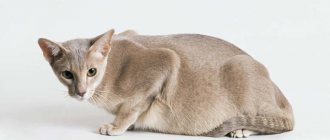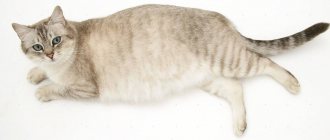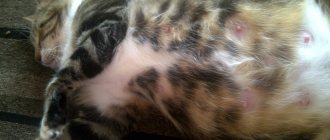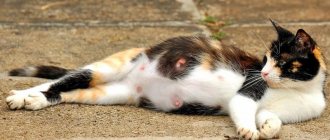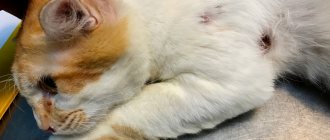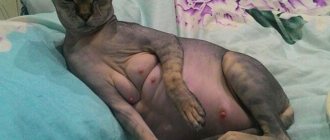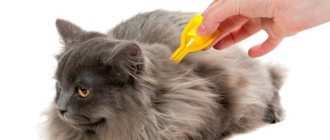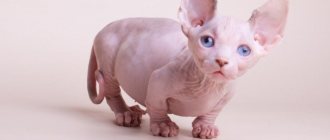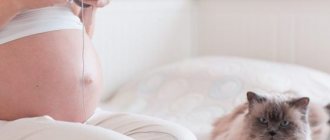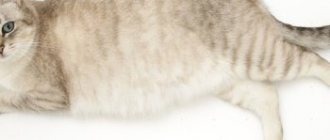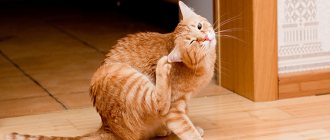Professional breeders, like ordinary owners, should understand how pregnancy occurs in cats. After all, the life of not only the pet, but also future kittens depends on what kind of care the animal receives during fruiting and how this period goes.
Professional breeders, like ordinary owners, should understand how pregnancy occurs in cats
Signs of pregnancy in the first days
In the first days after fertilization, it is almost impossible to suspect pregnancy in a pet. Only some subtle signs will indicate its condition, but they do not give a 100% guarantee:
- increased drowsiness - a particularly noticeable sign in active cats, as playfulness gives way to calmness, in this case the owner may suspect the appearance of a somatic disease. This condition is formed due to changes in the hormonal background of the animal;
- cessation of estrus earlier than usual is an indirect sign of conception. On average, the period lasts about three days, so a reduction in the duration of the phase may indicate fertilization;
- a few days after mating, there may be a decrease in appetite due to the occurrence of nausea in the animal, while normally a pregnant cat does not experience frequent vomiting and complete refusal of food, such symptoms may indicate the presence of a disease;
- changes in nipple pigmentation occur under the influence of hormones, while the skin intensifies its color; this sign is in many cases difficult to detect from the first days of pregnancy.
Also read the article about when a cat starts walking.
Results
Also, be attentive to signs of toxicosis in a cat, because pregnancy can lead to exacerbations of various diseases and nausea and vomiting will then not be side effects from hormonal changes, but symptoms of the disease. If vomiting is profuse and not related to the time of day, contact your veterinarian.
Also, in the early stages after controlled mating, you can do a test for the hormone relaxin, which acts as feline hCG, on the 20th day.
IMPORTANT: if there are two cats living in your house and one of them becomes pregnant, then monitor the reaction to this event in the second female. The cat world is structured in such a way that the second madam can imagine a false pregnancy. Then it is worth showing her to a veterinarian and carrying out hormonal treatment, because a false pregnancy does not benefit either the physical or mental health of the animal.
At what stage can pregnancy be determined?
So, how can you tell if your cat is pregnant? The owner can detect pregnancy in a cat starting from 28 days - during this period, the female experiences an increase in abdominal circumference, swelling of the nipples, changes in behavior, and cessation of estrus.
Ultrasound of a pregnant cat
By consulting a doctor, pregnancy can be detected from about 20 days after fertilization. For this, an ultrasound is performed, which will accurately determine the presence or absence of fetuses in the uterus.
Unlike people, cats do not secrete the hCG hormone into the blood, but instead the placenta secretes relaxin. Testing for this hormone can be done from the 20th day after mating. False-positive results are possible if the animal has an ovarian cyst.
From the 28th day you can notice the first movement of the offspring. During the same period, palpation can be carried out by palpating the side walls of the abdomen.
An X-ray of the abdominal organs is performed after 50 days of pregnancy. The method reliably diagnoses the fertilization that has occurred, and also allows you to determine the number of offspring and their position.
General information
On average, a cat's pregnancy lasts 55-70 days; the larger the breed, the longer the cat bears kittens. But the problem of determining whether conception has taken place is the same for all purebred and outbred cats - until the 25th day you will definitely not be able to check the presence of fetuses in the uterus. Yes, there are signs of successful conception that apply after a planned mating, but all of them can also be the consequences of a false pregnancy. And it is especially difficult to determine whether a cat is pregnant or not if the animal has free access to the street or even lives in the local area without constant supervision.
General signs of pregnancy
After mating, the owner must carefully monitor the condition of the cat, since the appearance of uncharacteristic symptoms may indicate a pathology of pregnancy. In addition, intercourse sometimes does not lead to fertilization, resulting in the need for additional mating.
The most informative signs of pregnancy include an increase in the size of the abdomen, changes in behavior, cessation of estrus and some other manifestations.
Termination of heat
Estrus refers to the manifestation of the period of arousal in the sexual cycle. The processes accompanying this stage are aimed at changing both the behavior and the state of the cat’s reproductive tract, which will contribute to attracting a male and fertilization. Accordingly, in the case of successful conception, continuation of estrus is not advisable, so signs of arousal disappear - the vaginal mucosa loses hyperemia, the secretion stops being released from the loop.
If estrus continues after mating, this indicates a failed pregnancy. If the lack of conception is confirmed, the breeder will have to resort to re-mating the female.
Changing nipples and belly
The earliest sign of pregnancy in a cat is a rounding of the abdomen due to an increase in the size of the uterus as a result of the growth of the fetus. The sign is usually detected after one month from the date of mating. The rate of growth of the abdomen, as well as its size, depend on the individual characteristics of the female, the number and size of the offspring. During this period, the first movement can be determined by palpation. To do this, carefully palpate the lateral sections of the abdomen.
Changes in nipple pigmentation begin in the first days after conception. The color becomes brighter, they acquire the maximum pink tint in the last stages. The greatest change in color is typical during a cat's first pregnancy. As delivery approaches, the nipples swell, which is a preparation for breastfeeding the offspring. Such changes are caused by the action of hormones.
The first release of milk, or rather colostrum, occurs approximately seven days before the kittens are born. The secreted substance contains a large amount of protein and fat, and subsequently its composition changes somewhat.
Behavior change
The most common symptoms are increasing weakness and lethargy. An active cat becomes calmer, spends most of its time lying down, and loses interest in games. In phlegmatic pets, the signs are less noticeable. This condition is associated with the action of hormones.
In some cases, there is an increase in activity - an unsociable cat begins to show affection and demand more attention, a sedentary cat becomes playful.
Sometimes a change in behavior is accompanied by the appearance of aggression, which is most often characteristic of sphinxes.
A sharp change in taste preferences is possible - the cat happily eats food that it did not like before, but refuses its favorite foods. The process is explained by a condition similar to toxicosis in women.
We recommend reading the article about discharge in a pregnant cat.
Nesting
The maternal instinct of a cat is expressed in the desire to create comfort for future offspring. An animal can actively look for a place to give birth - the pet will sniff it, spend a lot of time there, and drag soft objects there.
Most often, the animal chooses a secluded “den”, where there are no adverse effects of the environment - drafts, dampness, and also away from people. Care should be taken to ensure that the cat does not lamb in a place inaccessible to humans.
We recommend reading the article about how long pregnancy lasts in cats.
Preparing for childbirth
Owners must prepare for childbirth and create comfortable conditions for her. Within a week, a structure is installed in which the woman in labor will hide. A box with a low side, a bed, etc. is suitable. The area should be large so that the mother and kittens do not feel crowded. You should also ensure that people have access to this box in case assistance is needed.
For childbirth, you need to prepare a first aid kit
In this case, the veterinary first aid kit should contain the following items:
- disposable and flannel diapers (used for lining and covering kittens);
- pieces of textile the size of a handkerchief for wiping (gauze is not suitable);
- chlorhexidine or alcohol for cleaning tools and hands;
- the smallest size syringe for removing fluid from the noses of kittens;
- to lubricate the loop during difficult labor - sterile petroleum jelly and a pipette;
- brilliant green for lubricating the umbilical cord;
- cotton buds;
- a heating pad for the bed of newborn kittens;
- scissors washed with boiling water with blades rounded at the ends;
- scales.
The following medications are included in the first aid kit:
- calcium gluconate in solution for injection - stimulates contractions;
- Mastomethrin - stops inflammation, disinfects;
- Travmatin - relieves pain during childbirth, regulates the strength of contractions.
Procreation is a basic instinct in animals
Pregnancy is a difficult period in the life of a female, including cats. It largely depends on the person how the gestation of kittens will go and whether the offspring will be healthy.
Rules for caring for newborn kittens
Diagnosis and false pregnancy
To find out for sure that pregnancy has occurred, you need to consult a specialist. The doctor will conduct an examination and, if necessary, prescribe additional examination methods:
- An examination by a veterinarian involves palpation to identify fetuses, as well as an external examination of the genital tract and the general condition of the cat.
- A positive result of a blood test for relaxin will indicate with high accuracy the onset of fertilization from the 25th day.
- Ultrasound allows you to accurately diagnose pregnancy from day 25.
- X-rays are performed after 50 days.
Cats are characterized by the phenomenon of false pregnancy. The etiology is not fully understood, but experts are inclined to believe that the cause of the condition is the effect of the hormone prolactin. Imaginary pregnancy in cats occurs after ovulation in the absence of fertilization of the egg. At the same time, the cat shows signs of conception - changes behavior, nests, and stops estrus.
False pregnancy can be diagnosed by a negative test result for relaxin, the absence of fetuses on palpation, according to ultrasound and radiography.
Features of caring for a pregnant cat
Pregnancy is a test for a cat’s body. Since all vital organs work in an intensive mode, the animal requires special care and attention. Favorable conditions play a big role in the course and outcome of the condition.
The cat should be kept in a spacious, well-ventilated room without drafts at a comfortable temperature. High humidity and dark lighting are unacceptable.
You should ensure that your cat does not climb onto high furniture, as a fall or awkward landing can lead to serious consequences.
In the later stages, you should help the cat with hygiene, since the large size of the abdomen does not allow the cat to carry out the necessary toileting of the genitals and fur.
From the author. If the cat is not on a natural diet, then during pregnancy and nursing it should be switched to kitten food of at least premium class, and preferably super premium or holistic. Read a separate article about the right choice of premium food for kittens.
What to feed
The general principles of feeding a pregnant cat include following some rules:
- The diet should consist of high-quality feed, rich in all necessary substances.
- It is recommended to provide easily digestible food.
- A pregnant cat requires more frequent feeding. By the second trimester, the daily norm increases by about 50%.
- In the later stages, you should resort to fractional meals 6 times a day.
- It is important to regularly check the presence of water in the drinking bowl. Dehydration leads to abortion, which can cause the death of the cat.
Also read the article about whether a pregnant cat can be sterilized.
Symptoms of the onset of labor
Early warning signs of childbirth are sagging of the abdomen as a result of relaxation of the ligaments, as well as retraction of the sacral region.
On the eve of delivery, swelling of the genital organs and mammary glands occurs, and droplets of colostrum are released. Viscous mucus without pathological impurities comes out of the loop.
Read the article about bleeding in a pregnant cat.
When labor occurs, the water breaks, releasing a grayish-pink fluid. Then contractions appear, which normally last for an hour, which, if the outcome is favorable, end with the birth of offspring.
How do you know when lambing is approaching?
Lambing begins with the loss of amniotic fluid and can last up to 24 hours. The first kitten is born about an hour after contractions. The rest are at intervals of 10 minutes. From 2 to 7 kittens are born. If contractions continue for a long time - 3-5 hours or more, you need to call a veterinarian
After labor has stopped, the abdomen is carefully felt to ensure that all kittens have been born. Born kittens must be placed with their mother in a warm, draft-free nest.
Often, a cat hides its newborns in secluded corners until the babies begin to move independently.
First pregnancy
Puberty of the female occurs on average at 7-8 months of life. In this case, the cat experiences gradually changing periods of the cycle.
- The arousal stage corresponds to the period of maximum readiness of the animal for conception. Changes in the genital organs occur under the influence of gonadotropic hormones. In this case, the appearance of estrus is observed, which is characterized by swelling, edema and hyperemia of the vulva, and the release of mucus from the loop. Sexual arousal is accompanied by a change in the pet’s behavior - the cat becomes restless, active, and its appetite decreases. Next, the heat stage is formed, which is characterized by the female’s readiness to mate; at this moment she looks active and restless. Ovulation is the release of a mature follicle. This process in cats has its own peculiarity - the mechanism starts only after sexual intercourse after 1-2 days.
- The period of inhibition indicates a decrease in sexual activity. At this moment, the cat’s estrus ends: the mucous membranes of the genital tract return to their normal state, and the secretion of mucous secretion stops.
- The balancing period is characterized by the restoration of the cat's behavior and lack of attraction to males.
It is most favorable for the first pregnancy to occur at the age of more than a year, since the animal’s body reaches a mature state. Conceiving at a younger age can lead to pregnancy pathologies, complicated childbirth and diseases of the offspring. We recommend reading the article about a cat’s first birth.
1111
